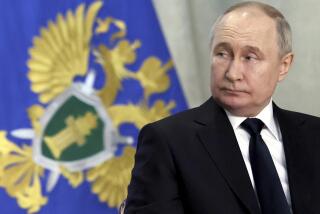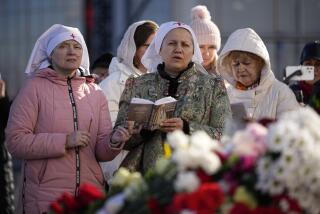Yeltsin’s Chief Foes Surrender : Parliament Left Burning; Shooting Continues : Russia: President bans ultranationalist and Communist parties, shuts opposition newspapers. Death toll put at 32 after 34 hours of fighting.
- Share via
MOSCOW — Following Moscow’s bloodiest political battle since the Bolshevik Revolution of 1917, the leaders of a 13-day parliamentary rebellion surrendered Monday after tanks punched holes in the Russian White House and left it aflame.
As the Parliament building burned, hundreds of “White House defenders” streamed out of the blackened marble fortress with their hands on their heads. Soldiers loyal to President Boris N. Yeltsin hauled bodies out of the smoking building while snipers loyal to rebel Vice President Alexander V. Rutskoi continued to fire at them from rooftops nearby.
As the boom of tank cannon echoed through their streets, Muscovites lined up to donate blood. Hospitals filled with gunshot victims. In 34 hours of near-constant fighting, 32 people were killed and 369 injured in the capital, authorities said Monday evening. However, the death toll was expected to rise.
Yeltsin moved swiftly Monday to smother the remains of his political opposition. The president signed two decrees Monday that banned several Communist and ultranationalist parties--thus depriving them of the ability to challenge him in elections scheduled for December--and shut down at least eight opposition newspapers.
Rutskoi and Parliament Chairman Ruslan I. Khasbulatov, who had defied Yeltsin’s Sept. 21 order dissolving Parliament and calling new elections, left their underground command bunker Monday evening and surrendered.
Arrest warrants were issued for two opposition leaders blamed for organizing and inciting the anti-Yeltsin violence that has consumed Moscow for three days.
“This is not simply the suppression of a mutiny. . . ,” said Sergei A. Filatov, the president’s chief of staff. “This is the nipping in the bud of a second civil war.
“Russia already fought one civil war this century, and that war claimed 13 million human lives,” Filatov added. “This would have been an even more horrible civil war. It would not be merely a Yugoslav version, it would be a war in a nuclear power.”
But as sniper fire continued and sporadic gun battles occurred in the streets of Moscow early today, there were signs that the anti-Yeltsin forces were not giving up easily.
“If Yeltsin thinks this is the end, we have to disappoint him and assure him this is just the beginning,” said Konstantin L. Savchenkov, a pro-Parliament businessman who came to watch the attack on the White House. “August, 1991, was just kindergarten. . . . The people will never forgive him for this.”
Yeltsin, however, was maintaining a tough stance. Aides on Monday denied an earlier report that he had agreed to simultaneous elections for the Parliament and the presidency. They reiterated his position that the parliamentary elections should be held in December and presidential elections in June.
The assault on the White House began at 8 a.m., when 10 tanks and a slightly larger number of armored personnel carriers that had encircled the building overnight began blasting away at the edifice that had once been the symbol of Yeltsin’s resistance to the pro-Communist coup against Soviet leader Mikhail S. Gorbachev in 1991.
The first small band to surrender came out of the White House at 2:30 p.m. waving a white flag, but it was not until 4:50 p.m. that hundreds of lawmakers and their supporters began to stream out. They were taken away to jail by bus.
CNN showed footage of angry riot police punching one prisoner in the jaw, as well as scenes of a doctor, said to be enraged at the casualties in the White House, cuffing disarmed prisoners on the head. Some of the prisoners were police who had defected to Parliament’s side.
There was also television footage of two helmeted riot policemen striking a prisoner repeatedly with their white batons, until a man in army uniform stepped forward and waved them off. About an hour later, Rutskoi, dressed in green army fatigues and white sneakers, and Khasbulatov, in a dark suit, emerged from an underground command bunker and gave up.
A Yeltsin aide, Dmitri Ryurikov, said the surrender was brokered by unnamed European diplomats who secured guarantees from the Yeltsin camp that the president’s former allies in the pro-democracy movement would not be shot.
The two leaders, together with four other members of the “alternative government” appointed by Parliament, were being held in Lefortovo prison, a grim pre-revolutionary dungeon on the eastern outskirts of Moscow.
The KGB prison has housed a number of people who embarrassed Russian leaders, among them American U-2 pilot Francis Gary Powers in 1960 and German teen-ager Mathias Rust, who eluded vaunted Soviet air defenses to land his plane in Red Square in 1987. On Monday it also held Viktor P. Barannikov, who headed the KGB until Yeltsin sacked him last summer.
It was not clear what charges might be brought against the parliamentary leaders. The plotters of the failed 1991 coup are still awaiting trial. But Yeltsin is not known for being magnanimous toward defeated enemies.
“There can be no forgiveness” of Parliament leaders, Yeltsin said in a televised address Monday morning, “because they have raised their hand against peaceful people, against Moscow, against Russia, against women, children and old people.”
The sniper fire that continued long after the leaders surrendered Monday highlighted the question that any court will have to answer: To what degree did the parliamentary leaders excite their followers to violence? And to what degree were they the hostages of the hard-line forces that were openly spoiling for a fight even before Yeltsin took the admittedly unconstitutional step of dissolving Parliament?
Moscow’s military commander, Alexander Kulikov, said Monday that more than 2,000 submachine guns, as well as grenade launchers, had been stored in the White House.
Kulikov also blamed Gen. Albert Makashov, a former candidate for president against Yeltsin in 1991 and the chief of the Ural military district, for organizing a raid Sunday on the Ostankino television center in which one video technician and two journalists were killed and many other people injured. Makashov was among those jailed on Monday.
Arrest warrants were issued for Communist leader Viktor A. Anpilov and for Ilya Konstantinov, co-chairman of the far-fight National Salvation Front. Konstantinov helped direct the storming of the Moscow mayor’s office on Sunday.
Anpilov and Konstantinov were heroes in the newspapers that Yeltsin banned Monday. These included the old Soviet official organ Pravda, the far-right nationalist Dien, and Glasnost, named for Gorbachev’s policy of openness and reform and now virulently anti-Yeltsin.
Some devotees of these hard-line groups came to the White House Monday and screamed abuse at pro-government forces. But the specter of the White House ablaze drew many ordinary Muscovites perilously close to the fighting. Monday was unseasonably sunny and mild, and at one point a crowd of at least 1,000 fascinated and horrified gawkers watched the battle from a bridge over the Moscow River. Hundreds more walked up side streets to try to get a better view.
Curiosity killed at least three of the spectators. One was a 16-year-old boy apparently felled by a sniper bullet after he came with his father to survey the scene and was caught in a firefight between pro-Parliament paramilitary troops and pro-Yeltsin soldiers. He died at about 8 p.m. Monday while trying to run from the shooting.
Most Muscovites went to work, however. Surface traffic was paralyzed by closure of key streets and bridges around the White House, and downtown subway stations were shut in an effort to keep people out of central Moscow.
In Washington, Strobe Talbott, President Clinton’s ambassador-at-large to the nations of the former Soviet Union, said that five Americans had been wounded in the fighting, one of them a Marine guard at the U.S. Embassy, located near the White House. The Marine was struck in the neck by a stray bullet but was said to be out of danger.
When darkness fell on the convulsing city, flames were still shooting from the windows of the White House. Attempts to quench a blaze that consumed the eighth to 14th floors were thwarted by snipers stationed on the top floor of the 19-story building and on nearby rooftops, firefighters told the Interfax news agency.
Bandits staged an unsuccessful attack on a police office in the Leningradskaya railway station, the prosecutor’s office reported. The purpose of the attack was not clear, unless it was to seize weapons. A fierce firefight was also reported at the Baumanskaya subway station.
At 9 p.m. Monday the offices of the liberal newspaper Moscow Komsomolets were under attack. It was the third apparent attempt to seize mass media outlets seen as unsympathetic to Parliament.
Armed men had attacked Itar-Tass news agency on Sunday and again on Monday night, in addition to the attack on the Ostankino TV facility. Police arrested eight attackers and confiscated automatic rifles and Molotov cocktails. But early today more sniper fire slammed into a seventh-floor window. No Tass staffers were injured.
At the offices of Moscow Komsomolets, one of the city’s most popular newspapers, journalists could not flee their third-floor quarters, which were being shattered by gunfire, because fighting also consumed the first floor.
The paper will not appear today, editor Vadim Poegli told Itar-Tass, because the printers spent the evening huddling in a bomb shelter in the basement.
A curfew was declared between 11 p.m. and 5 a.m., with 5,000 police and Interior Ministry troops ordered to patrol the city.
Inside the White House, crack Alpha troops were said to be going door to door trying to flush out any militants still holed up inside.
“No one knows yet how many have been killed,” said Mikhail K. Ivanov, a 22-year-old police private who said he saw dozens of dead or wounded carried out. “It is very dangerous to hang around this building because some of the militants are still occupying the upper floors.
“Get lost, otherwise you might be a wonderful target for the snipers,” he added.
Across the street, soldiers and police had taken over the Ukraine Hotel, which offered a bird’s-eye view onto about three dozen tanks sent as reinforcements to the burning Parliament building and an equal number of armored personnel carriers.
On the ninth floor, reporters were warned to stay away from the windows. Fifteen minutes earlier, a 33-year-old army captain had been killed by a sniper bullet. Government troops with sniper rifles of their own were standing guard.
Meanwhile, on the Kutuzovsky Bridge near the White House, the army was hunkering down for another fight.
A young lieutenant ordered his soldiers to begin unpacking 14.5-millimeter machine-gun cartridges and loading them into magazines to be shot from armored personnel carriers.
“I fear a wave of terror in the city, as there are still too many Rutskoi supporters who managed to escape the White House and are well armed,” said the police major in charge of guarding the bridge. “They call it civil disobedience, but it is plain terror. Moscow will certainly be a more dangerous place for some time.”
Andrei V. Ostroukh and Alexei V. Kuznetzov of the Moscow Bureau contributed to this report.
* STANDING BY YELTSIN: Oresident Clinton says “tough action” was necessary. A8
* RELATED STORIES, PHOTOS AND GRAPHICS: A5-A9
Storming the Parliament
More than 700 Russian troops retook the Parliament building with overwhelming force, including at least 10 heavy tanks, seven light tanks, and 25 armored personnel carriers. Here is how the attack on the white marble building took place:
1) Around 7 a.m. Moscow time, T-72 tanks pound the Parliament building. Machine guns fire on the building from nearby buildings.
2) Parliament’s defenders fire back from the barricaded building as well as from the nearby mayor’s office.
Yeltsin’s forces cease fire at noon to allow surrender. Government officials say 72 people, mainly women, come out with their hands up.
3) Yeltsin’s defense minister, Pavel Grachev, arrives to negotiate with a group of hard-liners who come out waving a white flag. He hands them a paper that is believed to be an ultimatum to give up or face destruction.
Sporadic firing resumes. Hard-liners then begin filing out. Their leaders--Parliament Chairman Ruslan Khasbulatov and Vice President Alexander V. Rutskoi--are among the last to give up.
Other Conflicts Around Moscow
KREMLIN: At least 40 armored vehicles stand outside. Yeltsin supporters gather nearby.
TV COMPLEX: Government forces continue to battle anti-Yeltsin forces but hold the building.
CITY HALL: Yeltsin supporters erect barricade near City Hall
Source: Times staff
More to Read
Sign up for Essential California
The most important California stories and recommendations in your inbox every morning.
You may occasionally receive promotional content from the Los Angeles Times.













